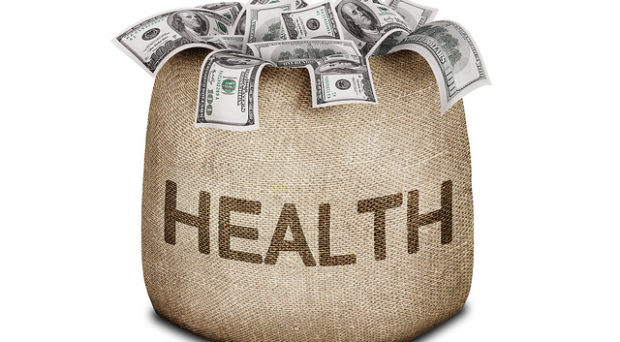
Larger wine glasses may lead people to drink more
Alcohol consumption ranks 5th among the 20 leading risk factors for global burden of disease and BMC Public Health has published an array of articles this year on harmful drinking. Theresa Marteau et al. carried out a study in an eating and drinking establishment in Cambridge, England, which reports the effects of wine glass size on wine sales. During the study, the size of wine glasses were  changed at fortnightly intervals and, over a 16-week period, the establishment alternated between the standard 300ml wine glass, to the larger 370ml and smaller 250ml glasses. Data showed that the volume of wine purchased was nearly 10 percent higher when sold in larger glasses compared to standard-sized glasses. Interestingly, Marteau et al. did not see the opposite effect when they switched to smaller wine glasses. The results indicate that avoiding the use of large wine glasses could reduce the amount that people drink. However, more research is required to confirm the effect and, should this suggest glass size might be an effective target for intervention, the next step would be to explore how this might be implemented.
changed at fortnightly intervals and, over a 16-week period, the establishment alternated between the standard 300ml wine glass, to the larger 370ml and smaller 250ml glasses. Data showed that the volume of wine purchased was nearly 10 percent higher when sold in larger glasses compared to standard-sized glasses. Interestingly, Marteau et al. did not see the opposite effect when they switched to smaller wine glasses. The results indicate that avoiding the use of large wine glasses could reduce the amount that people drink. However, more research is required to confirm the effect and, should this suggest glass size might be an effective target for intervention, the next step would be to explore how this might be implemented.
Mental health outcomes in times of economic recession
Economic recessions are known to affect people’s health and wellbeing. Diana Frasquilho et al. have carried out a systematic review which looks at the recent evidence of the possible association between economic recessions and mental health outcomes. They found that, in general, evidence on the impact of economic crises and recessions on mental health is accruing, but comprehensive studies are lacking. Although periods of economic recession are possibly associated with a higher prevalence of mental health problems, including common mental disorders, substance disorders, and ultimately suicidal behavior, most of the research is based on cross-sectional studies, which seriously limits causality inferences. Diana Frasquilho explains more about the review’s findings here.
Do you know what you are smoking?
 Marcella Boynton et al. conducted a nationally-representative phone survey of U.S. adults with questions related to tobacco constituent information, knowledge, and perceptions. Surprisingly, the authors’ results reveal that groups one might presume to be the least psychologically motivated to look for this information, young adults and smokers, were more likely to say that they had previously looked for it. Furthermore, more than 80% of U.S. smokers reported intending to eventually quit smoking, suggesting that many smokers are in the contemplation stage of behavior change and would therefore benefit from greater access to constituent information. The researchers also asked respondents whether they had heard that each of 4 constituents are in cigarette smoke and found that, with the exception of nicotine, most people were largely unaware of what chemicals are present in tobacco products.
Marcella Boynton et al. conducted a nationally-representative phone survey of U.S. adults with questions related to tobacco constituent information, knowledge, and perceptions. Surprisingly, the authors’ results reveal that groups one might presume to be the least psychologically motivated to look for this information, young adults and smokers, were more likely to say that they had previously looked for it. Furthermore, more than 80% of U.S. smokers reported intending to eventually quit smoking, suggesting that many smokers are in the contemplation stage of behavior change and would therefore benefit from greater access to constituent information. The researchers also asked respondents whether they had heard that each of 4 constituents are in cigarette smoke and found that, with the exception of nicotine, most people were largely unaware of what chemicals are present in tobacco products.
Smokers trying to kick the habit tend to also give up drinking
Smoking and excessive alcohol consumption have a close and complex relationship which warrants research sometimes looking at these major public health problems in conjunction. Jamie Brown et al. looked at whether, at a population level, smokers who have recently attempted to quit smoking are more likely than other smokers to report lower alcohol consumption and trying to reduce their drinking. A total of 31,878 adults in England were surveyed between March 2014 and September 2015 and the researchers found that smokers who reported attempting to stop within the last week had lower levels of alcohol consumption, especially bingeing, and were less likely to be classified as having higher risk alcohol consumption compared with those who did not report an attempt to quit smoking in the last week. Results indicate that smokers in England may be following best-practice advice to restrict their alcohol consumption during a smoking cessation attempt. However, due to the nature of the study, it is not clear whether the effects seen are due to reverse causation: ie, that the association between quitting and consumption is actually driven by people with lower alcohol consumption being more likely to attempt to quit smoking. In either case, the study findings have important implications for policy evaluation and justify a coordinated strategy on alcohol and tobacco control.
Live broadcasts of online suicides
According to the World Health Organization, suicide is the second leading cause of youth death globally. With social media becoming  a central part of everyone’s lives, more young suicidal people are going online and this may provide increased opportunity for a crisis response. Jing Ma et al. explored live-broadcast suicide in Chinese emerging adults and collected data on the suicide incidents, stages/process, participants and their behaviors. Findings revealed that important information can be obtained from accounts of these incidents, which could contribute to a better understanding of suicidal people, those who encourage suicidal behaviors in others, and, most importantly, how suicide could be prevented in an online environment.
a central part of everyone’s lives, more young suicidal people are going online and this may provide increased opportunity for a crisis response. Jing Ma et al. explored live-broadcast suicide in Chinese emerging adults and collected data on the suicide incidents, stages/process, participants and their behaviors. Findings revealed that important information can be obtained from accounts of these incidents, which could contribute to a better understanding of suicidal people, those who encourage suicidal behaviors in others, and, most importantly, how suicide could be prevented in an online environment.
People judge how drunk they are based on those around them and NOT how much they’ve consumed
In this study, Simon Moore and colleagues examine for the first time how people judge their drunkenness and the health consequences of their drinking whilst they are intoxicated in social drinking environments. The authors carried out breath alcohol testing of 1,862 people and asked a subset of them about their perceptions of their drunkenness and the health consequences of their drinking. Their results show that people base judgements regarding their drinking on how their level of intoxication ranks relative to that of others of the same gender around them, not on their actual levels of intoxication. These findings have implications for strategies looking at increasing the numbers of sober people in night time environments.
Owners of big dog breeds more likely to walk their pets
 Although dog ownership is associated with increased physical activity through walking, many people who live with dogs do not walk them regularly. Carri Westgarth and co-authors carried out a study examining the demographic and behavioral factors that contribute towards owners reporting having a strong sense of encouragement and motivation to walk provided by their dogs. They found that factors such as owning a larger dog, having an increased level of attachment to their dog, knowing their dog enjoys going for a walk, believing walking keeps dogs healthy and having high social support from family to go walking, were positively associated with both outcomes ‘dog encouragement to walk’ and ‘dog motivation to walk’. These factors may be targeted in future interventions to increase and maintain physical activity levels of both people and pets.
Although dog ownership is associated with increased physical activity through walking, many people who live with dogs do not walk them regularly. Carri Westgarth and co-authors carried out a study examining the demographic and behavioral factors that contribute towards owners reporting having a strong sense of encouragement and motivation to walk provided by their dogs. They found that factors such as owning a larger dog, having an increased level of attachment to their dog, knowing their dog enjoys going for a walk, believing walking keeps dogs healthy and having high social support from family to go walking, were positively associated with both outcomes ‘dog encouragement to walk’ and ‘dog motivation to walk’. These factors may be targeted in future interventions to increase and maintain physical activity levels of both people and pets.
One in seven UK 11-year-olds have drank alcohol
Yvonne Kelly and colleagues have found that UK 11-year-olds whose parents drink heavily are almost twice as likely to drink themselves than if their parents are non-drinkers – and particularly if their mother rather than their father is a heavy or regular binge drinker. Children who said their friends drank were also more than four times as likely to drink themselves as those children who had friends who didn’t drink. The researchers carried out an analysis of data from the UK Millennium Cohort Study on 10,498 11-year-olds and results obtained suggest that their perceptions of risk, their expectancies towards alcohol and relationships with their families were independently related to the likelihood of drinking. Yvonne Kelly explains more about this work in a blog here.
Internalizing the social cost of carbon into food price alongside a tax on sugary drinks
 Up to 30% of global greenhouse gas emissions (GHGEs) are estimated to arise from agriculture and associated land use change and therefore changing food consumption patterns may contribute substantially to reducing these gas levels. However, in attempting to reduce the consumption of foods with high GHGEs, other unhealthy food products which are low in GHGEs, such as sugar, may be preferred by consumers. In order to promote foods with low GHGEs and, at the same time, mitigate the negative health consequences of choosing low GHGE foods, Adam Briggs et al. modelled the effect on UK non-communicable disease mortality and GHGEs of internalizing the social cost of carbon into the price of food alongside a 20% tax on sugar sweetened beverages (SSBs). Results of the study indicate that incorporating this cost into food prices has the potential to improve health, reduce GHGEs and raise revenue. Furthermore, the SSBs tax can alleviate negative health consequences. The study, which is the first of its kind, has laid the groundwork for future research which is needed on developing sophisticated price structures to optimize a healthy population diet that is low in GHGEs.
Up to 30% of global greenhouse gas emissions (GHGEs) are estimated to arise from agriculture and associated land use change and therefore changing food consumption patterns may contribute substantially to reducing these gas levels. However, in attempting to reduce the consumption of foods with high GHGEs, other unhealthy food products which are low in GHGEs, such as sugar, may be preferred by consumers. In order to promote foods with low GHGEs and, at the same time, mitigate the negative health consequences of choosing low GHGE foods, Adam Briggs et al. modelled the effect on UK non-communicable disease mortality and GHGEs of internalizing the social cost of carbon into the price of food alongside a 20% tax on sugar sweetened beverages (SSBs). Results of the study indicate that incorporating this cost into food prices has the potential to improve health, reduce GHGEs and raise revenue. Furthermore, the SSBs tax can alleviate negative health consequences. The study, which is the first of its kind, has laid the groundwork for future research which is needed on developing sophisticated price structures to optimize a healthy population diet that is low in GHGEs.
The alcohol harm paradox – why are the poor at increased risk?
A number of studies have shown that deprived communities suffer substantively greater alcohol-related morbidity and mortality despite reporting average alcohol consumption similar to their richer counterparts. It is unclear why this is true and possible explanations behind the paradox include that deprived populations are exposed to other health challenges that interact with higher levels of alcohol consumption or there may be epidemiologically relevant differences in patterns of consumption and types of alcohol consumed. Mark Bellis et al. sought to assess the hypotheses behind this paradox by carrying out a national telephone survey with English adults. Questions examined factors including: current and historic drinking patterns, combined health challenges (smoking, diet, exercise and body mass), and under-reported consumption (enhanced questioning on atypical/special occasion drinking). The researchers found that, among more deprived drinkers, alcohol consumption is more likely to be combined with smoking and poor diet, suggesting a multiplicative effect. The research also identifies higher levels of current and past ‘binge drinking’ among some deprived drinkers, which is known to weaken the protective effects of low consumption on, for example, ischaemic heart disease. James Nicholls, a co-author of this work, explains more about the study’s findings in a blog here.
Pessimism is bad for your heart 
There is an increasing amount of evidence connecting mental health and personality traits to coronary heart disease (CHD). Mikko Pänkäläinen et al. carried out an 11-year prospective cohort study and looked at levels of dispositional optimism and pessimism of the participants at baseline. They found that both men and women who died because of CHD were significantly more pessimistic at baseline than the others, whereas optimism did not seem to have any connection with mortality risk. The researchers conclude that, as pessimism levels can be measured easily and non-invasively, this might be a very useful tool together with the other known risk factors to determine the risk of CHD-induced mortality.
Comments